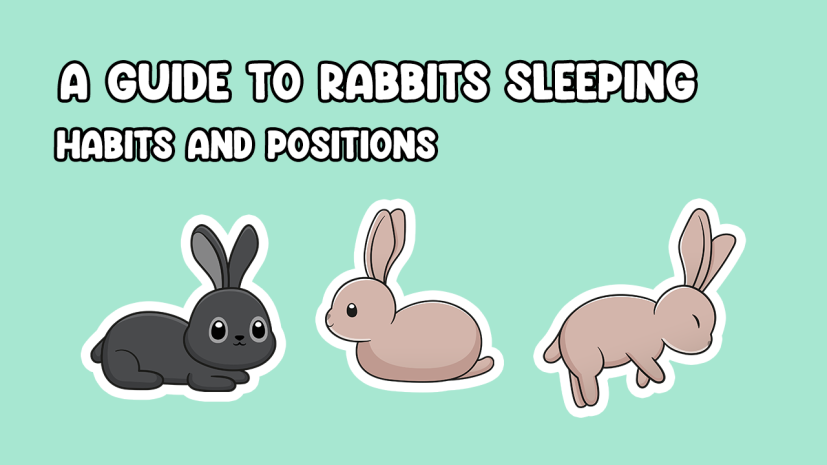
Since they’re prey animals, rabbits have evolved to have very specific sleeping habits to keep them safe. Pet rabbits sleep in a variety of positions depending on their personality and how comfortable they feel. They’re naturally on alert a lot of the time, so if they’re relaxed in your presence it’s quite the honor.
You might be surprised to know that it can be hard to tell when your rabbit is asleep! In this article, we will cover what your rabbits sleeping positions mean, why they sleep on their side, what happens if you put your rabbit on its back and more!

Rabbits might sleep in several positions depending on what feels comfortable to them and how relaxed they feel. If they live with another rabbit, your pet rabbit will likely sleep very close to their friend for security. Some common sleeping positions are listed below.

If you’ve ever seen a rabbit ‘flop’ you know it’s one of the cutest things ever. It can also be quite alarming if it’s the first time you’ve seen it and you don’t know what it is. A flop is when a bunny will sort of launch themselves onto their side from a standing position. When they hit the floor they’re all nicely stretched out on their side. In this position, they will typically close their eyes, fully relax, and go into a deep sleep.
This position is the most vulnerable position for a rabbit because they aren’t on alert, and it takes them a moment to get up if needed. Therefore, when a rabbit flops, this is the highest compliment as it means they are completely comfortable in their environment.
If it’s hot weather, you might see your rabbit flop more because it helps them to cool down. If a cool surface is available, they will likely flop or sprawl there (sprawling is explained below).
If a rabbit is very relaxed, they will often lie sprawled out. They will lie on their front and stretch their back legs, paws, and tail out behind them. They’ll often rest their head down on their front paws or on the floor. A lot of rabbit owners refer to this position fondly as a ‘sploot’.
If a rabbit sleeps in this sprawled position, it’s a great sign that they feel safe in their home. Their legs are not underneath them, so it makes them vulnerable and would take them longer to get up and run away if needed. If they snooze like this near you, it’s a great honor!
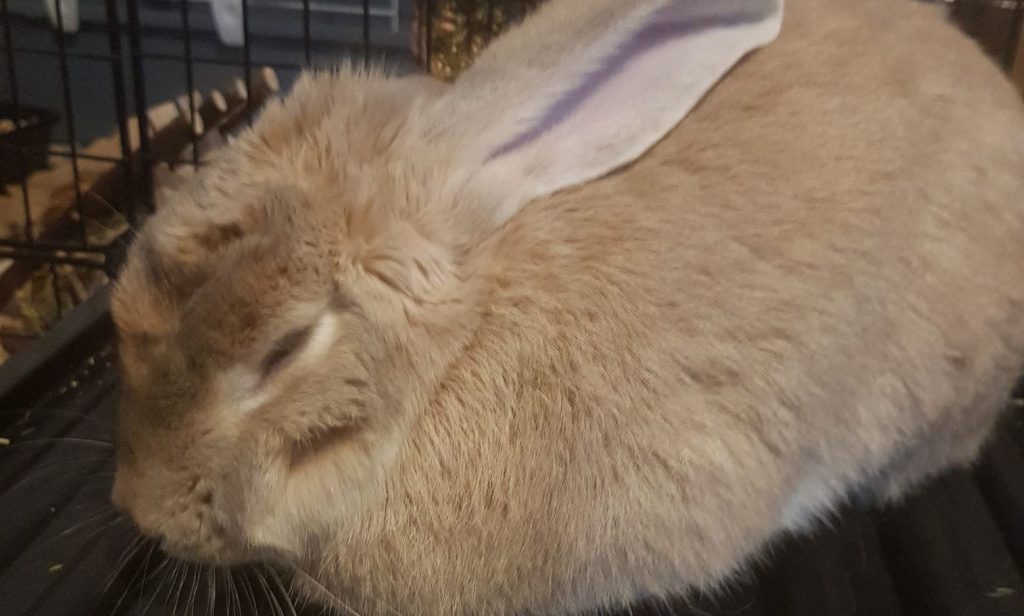
Rabbits will quite often tuck their little paws under their body and relax their head, making them look like a little fluffy loaf of bread. The loaf position is also seen in other animals and it’s simply adorable. It’s also very safe for a rabbit, as their feet are still under them so they can easily jump up and run away if they feel threatened.
It can be quite difficult to tell if a rabbit is sleeping or just relaxed when they’re in this position, especially when they sleep with their eyes open! If it’s cold weather, a rabbit is more likely to sleep in this position because when they’re all tucked up it helps to keep them warm.
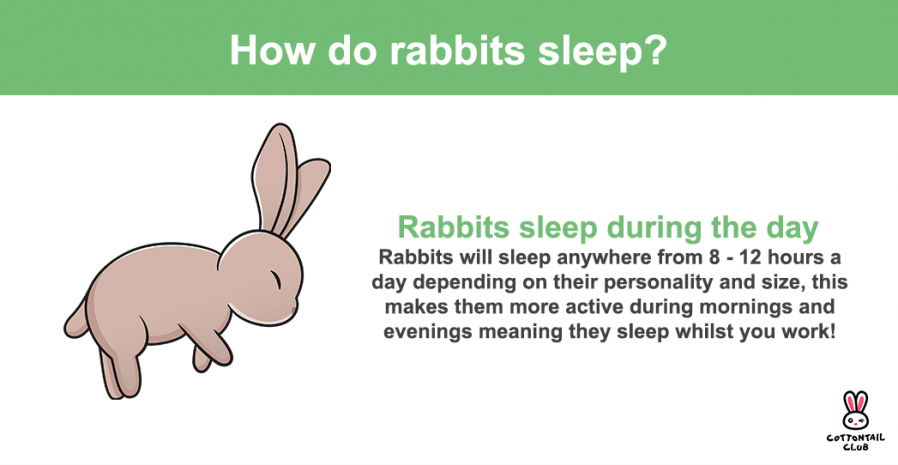
A healthy, happy rabbit will sleep for between 6 and 12 hours each day. Most rabbits tend to sleep around 8 hours on average.
Unlike ourselves, rabbits sleep for short periods, rather than in one long stretch like we do. This is because they are prey animals and in the wild, they need to keep an eye on their surroundings for signs of predators. Rabbits will experience both light sleep and deep sleep, but in both states they are able to wake up and be alert quite quickly.
f a rabbit feels safe, they will sleep more (closer to the 12-hour mark). If a rabbit is stressed or feels they aren’t in safe surroundings, they won’t sleep as much.
Just like humans, lack of sleep can take its toll on their bodies and increase the chances of them becoming unwell. It can also affect how well they can cope with illness. In fact, research found that rabbits who sleep well are more likely to survive an infection.
Rabbits sleep in short stretches throughout the day and night, like taking little naps. Blue Cross animal charity explains that rabbits are crepuscular, which means they’re mostly awake around dawn and dusk (Between Civil, Nautical, and Astronomical Twilight in the morning and evening). They can also be quite active overnight but tend to sleep a fair amount during the day.
This is because rabbits are prey animals and their wild ancestors would be less likely to be spotted by predators during these times. They’ve evolved to sleep at these times to keep them safe.
A lot of owners might not be awake or available at these times. Therefore, it’s important that your rabbit has access to a large living area and ideally has a run attached to their home, so they can exercise and exhibit natural behavior.
Once a domesticated rabbit settles into their new home, you’ll find that they follow a specific pattern and they will be most active in the early hours of the morning (5 am) and later in the evening (For us, around 11 pm).
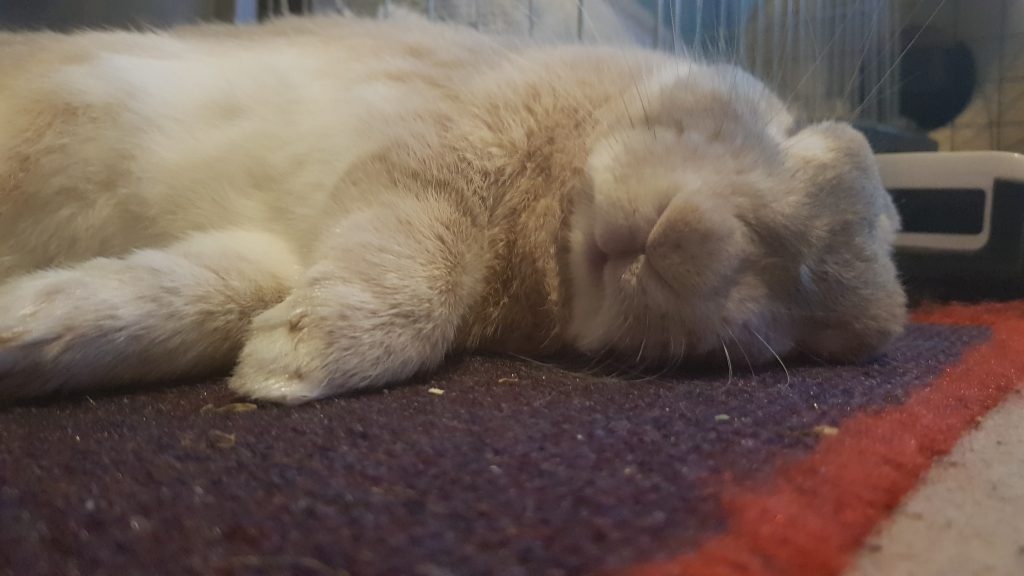
As we mentioned earlier, rabbits are prey animals so they have to be constantly on alert for predators. In the wild, they will quite often sleep with their eyes open so they can stay aware of their surroundings and detect movement. Some pet rabbits will sleep with their eyes open, especially if they don’t feel fully relaxed.
It’s important to note that rabbits have a third eyelid. This is a thin, translucent membrane that keeps their eye lubricated and stops dust or dirt from getting in their eyes. Even while their eyes are open, the third eyelid stays closed to protect their eye. Since they can see through it, they can keep an eye out for predators while they sleep! The third eyelid is also known as a nictitating membrane.
When a pet rabbit feels comfortable and safe in their home, they will sleep with their eyes closed or partially closed a lot of the time. This can take some time so don’t worry if you haven’t noticed them sleeping with their eyes closed yet!
There are advantages to sleeping with your eyes open as a rabbit and it’s quite a genius part of evolution:
You’ll often find with domesticated rabbits that sleep with their eyes open that they will be extremely jumpy during this time. If you’re able to, call out their name softly and slowly wave to avoid scaring them.
When rabbits are sitting up and snoozing with their eyes open it can be really hard to tell when they’re asleep. This serves them well in the wild so predators can’t tell they’re sleeping but it can be confusing for a rabbit owner. Thankfully, there are lots of signs you can look out for that tell you your rabbit is snoozing.
Signs your rabbit is asleep:
Rabbit’s noses are almost constantly on the move. A healthy, happy, alert rabbit will have a twitching nose when they’re awake. This changes when they fall asleep.
When they’re asleep, your rabbit’s nose might wiggle slowly rather than twitch quickly. It might even stop twitching altogether and become still. If you notice your rabbit’s nose is slowly wiggling or still and the rest of their body language is relaxed, there’s a good chance they’re sleeping.
When rabbits sleep their breathing slows down, just like humans. If you notice that your rabbit is breathing slower and more steadily than usual, they’re probably sleeping.
Most of the time a sleeping rabbit will relax their ears, meaning their ears will be resting down across their back. Sometimes a rabbit might still have upright ears when they’re fully asleep so it can be harder to tell.
The best way to tell if a rabbit is snoozing by looking at their ears, is if their ears aren’t moving. When they’re awake, their ears are often moving to track sounds in their environment. Their ears won’t do this when they’re sleeping and instead, will usually stay in the same position.
Sometimes rabbits will start to fall asleep while sitting up if they’re particularly relaxed or tired. You might see their eyes start to partially close and notice their breathing slowing. Their heads may drop as they nod off. They will likely settle down into a more comfortable position as they fall asleep.
You might be surprised to learn that rabbits dream. The table below shows some signs that your bunny is having a dream.
Signs your rabbit is dreaming:
If these signs are accompanied by relaxed body language, your bunny is probably happily dreaming. How cute! I wonder what they’re dreaming of? I imagine running and playing or eating their favorite snack.
Some rabbits snore just like humans! Our rabbit Hopkins always snored and it was pretty cute to see him snoozing and snoring away.
For a lot of rabbits, snoring is completely normal, however, for others it can be a sign of a respiratory problem. If your rabbit has never snored before and all of a sudden starts to snore, it’s best to get them checked by a vet just to be safe. If they’re snoring and also exhibiting other signs of ill health or changes in behavior, it’s time for a vet visit.
Rabbits do not naturally fall asleep when they are put on their backs. This position, often referred to as “trancing” or “tonic immobility,” is actually a state of fear-induced paralysis that occurs when a rabbit is extremely stressed or frightened.
This misunderstanding likely stems from the observation that rabbits will often close their eyes and remain still when placed in this position, which can give the appearance of peaceful sleep. However, it’s important to remember that rabbits are prey animals in the wild. When they are turned on their backs, a position that leaves them extremely vulnerable, their bodies instinctively react as though they are in danger.
Trancing is a defense mechanism. When a rabbit is captured by a predator, playing dead can sometimes encourage the predator to loosen its grip, giving the rabbit a chance to escape. Although this state may seem like sleep to an observer, it is usually a stressful experience for the rabbit and should be avoided.
Your vet may trance your rabbit to do varying tests such as X-Rays and radiography. This should not be cause for concern as a trained professional will be able to keep your safe.
The short answer is no, you can’t train your rabbit to sleep at night. Although it can be frustrating when they’re making a lot of noise during the night, this is their natural sleep pattern and it would be unfair to try to change it, even if you could.
However, there are some things you can do to try to reduce the noise they might make at night to make sure they aren’t disturbing the rest of the household. There are some tips below to get you started.
| Ways to Reduce Noise at Night | Examples |
|---|---|
| Mental and Physical Stimulation | During the day: Time out of their enclosure Interaction with owners, Games and puzzles, Toys to play with |
| Schedule | Consistency with the following during the day: Feeding times Play times and when they get attention Times out of their enclosure |
| Large living area | Plenty of room to: Stretch out,, Move and run around |
| Quiet toys | Chew treats, Puzzle toys, Quiet natural options |
| Quiet enclosure | Remove items that cause noise overnight |
Your rabbit needs plenty of space and time to run around and get some exercise during the day. Ideally, they need time out of their enclosure each day if they aren’t free roaming.
They also need lots of mental stimulation. You can give them toys to play with, give them plenty of interaction with you, and even play games with them. The more your rabbit is happy and has fun during the day, the more likely they are to settle down at night.
If rabbits are under-stimulated or bored, they’re more likely to try to create their own fun and make a lot of noise at night. You might even hear them thumping, which is often a sign of frustration.
Try to keep a consistent schedule of when your rabbit will be fed, get attention, and get out of their enclosure. This will reduce frustration overnight and let them relax knowing when they’re going to have some fun.
As we mentioned earlier, it’s crucial that their living area is large enough for them to move around comfortably and stretch out. In general, the larger the better. If your rabbit is in a space that’s too small for them, they’re understandably going to get frustrated and chew at their surroundings or thump.
To keep your bunny entertained overnight, you can give them rabbit toys that are perhaps quieter than the ones you would offer during the day. This might include long lasting treats to chew on or natural puzzle games for example.
There are ways you can make their enclosure quieter at night, such as removing things from their enclosure that are prone to making a noise and giving them back in the morning. This will vary depending on your rabbit, for example our rabbit would clank one of his hanging toys against his pen wall so we only gave it to him during the day.
Make sure you replace any toys you take away with something quieter, and ensure they always have hay and water overnight.
There’s a huge variety of places and objects your rabbit will sleep, from miniature beds (All the rage) to carpet mats, grass mats, and cardboard boxes.
If your rabbit sleeps in their cage, typically any safe bedding will be perfectly fine, however, the best option on the market is typically CareFresh Natural Paper Fibre Bedding.
If you have an indoor rabbit, you may want to splash out on something a little more comforting for their run area.
There’s no all-in-one solution for your rabbit, it’s all a matter of testing what suits their personality, but here are some things that your rabbit might like:




References
Toth, L. A., Tolley, E. A., & Krueger, J. M. (1993). Sleep as a prognostic indicator during infectious disease in rabbits. Proceedings of the Society for Experimental Biology and Medicine, 203(2), 179-192.
Blue Cross, (2022), Facts about rabbits.
Science Direct, (2022), Nictitating Membrane Overview Page.
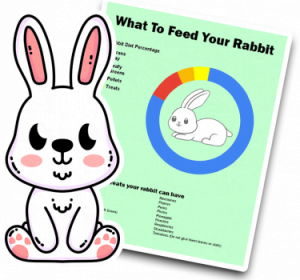
By entering your email address you agree to receive emails from Cottontailclub. We'll respect your privacy and you can unsubscribe at any time.